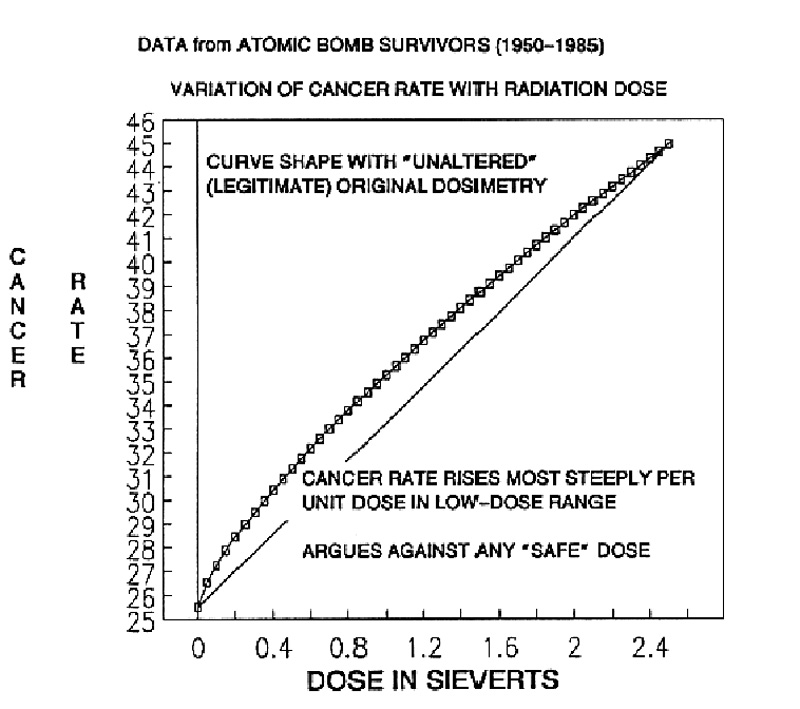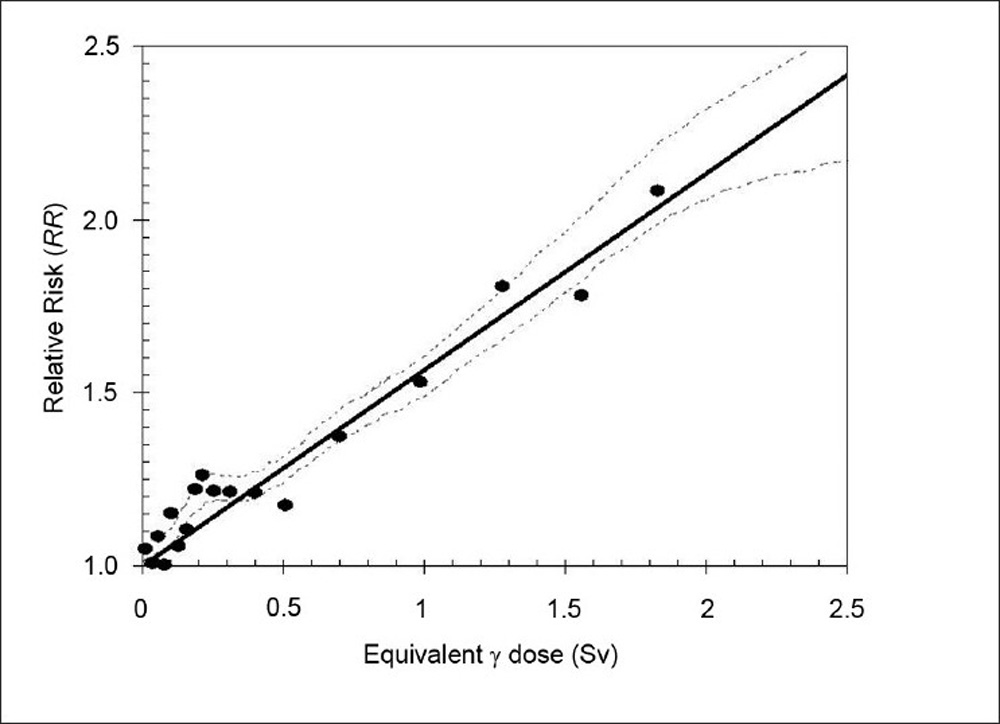This week, a new report about low dose ionising radiation was published, - one that should put a spanner in the works of the nuclear lobby. Studies of the Mortality of Atomic Bomb Survivors, 2012 Report 14, 1950 2003: An Overview of Cancer and Non- cancer Diseases.
But first of all, let me explain why this report is so important and so timely.
It's a year after the Fukushima disaster. So the nuclear lobby thinks that it's time to restart the nuclear renaissance, and to stop worrying about ionising radiation.
Advertisement
To this end, the industry, and particularly the U.S. Department of Energy, and the Nuclear Regulatory Commission have projects under way.
Two particular projects are going on – seemingly unrelated ones. But they are, in fact, closely related. Both aim to dampen the public concern about ionising radiation - indeed to promote acceptance of "low level radiation":
- One sets out to downgrade nuclear emergency procedures.
- The other aims at discrediting the scientifically accepted model on the cancer risk of low level radiation. (This model, known as the Linear No Threshold model (LNT) states that there is no level below which ionising radiation is not harmful, risk increases with each added unit of radiation)
The first project – weakening emergency safety standards. The USA's Nuclear Regulatory Commission and the Federal Emergency Management Agency have quietly downgraded nuclear emergency procedures. In particular, the new rules pretty much ignore the radiation hazard,( as discussed in Evacs and drills pared near nuke plants).
Among the changes to the original 1979 program for nuclear emergency action, they have eliminated a requirement that local responders always practise for a release of radiation. Also there is a new requirement that some planning exercises incorporate a reassuring premise: that no harmful radiation is released. As this article comments:
Advertisement
many state and local emergency officials say such exercises make no sense in a program designed to protect the population from radiation released by a nuclear accident ...
... The Japanese disaster reinforced such worries when officials told some towns beyond 12 miles from the disabled plant to evacuate. The U.S. government recommended that Americans stay at least 50 miles from the plant. Soil and crops were contaminated for scores of miles around. At one point, health authorities in Tokyo, 140 miles away, advised families not to give children the local water, which was contaminated by fallout to twice the government limit for infants.
And the NRC and FEMA plan to review procedures soon - in all likelihood, tocontinue their history of watering down safety standards, even wholly ignoring problems – when encountering violationsat the nation's aging reactors- (detailed by David Worthington, US nuclear safety regulations softened by industry influence).
The second project – discrediting the radiation risk model that underpins all the globally used standards on radiation safety and health risks. The U.S. Department of energy funds research projects, world-wide, that promote the theories of "radiation hormesis" and "adaptive radiation":
Radiation hormesis holds that at a low level radiation is not only harmless, but actually good for human health.
Adaptive radiation holds that people exposed to low level radiation over time, become resistant to its cancer-causing effects.
It's easy to see how well this fits in with a relaxing of the rules for safety around nuclear facilities, and a public complacency about Fukushima , Chernobyl, Three Mile Island, etc.
I don't want to spend too much time on the array of reports publicising these DOE-funded research efforts. The latest one comes from MIT, reporting on a study that suggests that at low dose-rate, radiation poses little risk to DNA - ( A new look at prolonged radiation exposure)This study was a five week one, done on mice - and coming out with the conclusion that the USA's nuclear emergency procedures might be too conservative, - i.e. paying too much attention to radiation risks. The study ignores "internal emitters" – i.e. the effects of a speck of radioactive material that might enter the body and lodge in the lung, or the gut. It ignores other research studies, such as on wildlife near Chernobyl. A very small number of mice were used in this experiment Total: 112 test subjects and 112 control
In quite a bewildering array of research studies funded by DOE the same reassuring results come up - complete with the same omissions and flaws. Prominent among these are:
The work of Bobby Scott of Lovelace Institute, New Mexico, and a DOE Low Dose contractor (ie the part of DOE called Low Dose Research, which promotes hormesis . He has written material which states that the Myak workers were protected by their radiation exposure. It is pure hormesis.
Australia's own Pamela Sykes, whose Adelaide research on mice, (showing low level radiation is OK) is funded by DOE. Sykes and Scott give talks on Hormesis at Los Alamos. and published papers together. They started the journal "Dose Response"
Now – to the new report on Low Dose Radiation - Studies of the Mortality of Atomic Bomb Survivors, 2012 Report 14.
In contrast to the MIT 5 week study on 224 mice, this study has covered 86,611 humans Japanese atomic bomb survivors, over a period of 62 years, carried out by a number of scientists in joint USA-Japan research. This Low-Dose Radiation NEW A-Bomb Study is the 14th report in a series of periodic general reports on mortality in the Life Span Study (LSS) cohort of atomic bomb survivors followed by the Radiation Effects Research Foundation to investigate the late health effects of the radiation from the atomic bombs.
A review of the study comments:
This landmark study of the survivors of the atomic bombings of Japan presents the strongest evidence to date that cancer risk not only exists at low levels of radiation, but may have greater risk per unit of dose than at higher doses. The study also shows that ionising radiation is associated with non cancerous diseases. Involving circulatory respiratory and digestive systems
Ian Goddard's analysis of the report includes these points : The study examines linearity and non linearity in the response to low dose radiation, that is whether or not the accepted scientific consensus of linearity holds good that there is no safe low dose of radiation, and that the risk of cancer increases with increased dose. It confirms that there is no threshold below which radiation doses are harmless, and continues to affirm the linear dose response.
For all cancer and non cancer diseases linearity shows the dominant explanation

Figure 1 Variation of cancer rate with radiation dose
The radiation hormesis theory (i.e low dose radiation is beneficial) gets some indication, a hint only – in some ranges, but over time, over the whole range. that connection evaporated and the results show systematic linear harm.
In 2000 the Foundation published another report with separate dose-response graphs for Hiroshima and Nagasaki .Results from Nagasaki and Hiroshima are slightly different. Hormesis advocates will try to point out a beneficial dose and might point out a single data point in the Nagasaki only cohort. But in Hiroshima with twice as large cohort, such a dip does not exist. The whole curve is far more linear and finds no dose below zero risk. When the two are combined the linear relationship between doses and cancer risk is clear, and with such a large number of people is a reliable result.
Non linearity at lowest dose may indicate that radiation is more harmful at the lowest dose

Figure 2 Radiation risk atomic survivors
Radiation induced genetic damage has been found to be higher at low doses. This further supports the likelihood that lower doses are more harmful. The clear signal supports the accepted linear theory and supports the consensus on risk modelling world wide.
The Goddard analysis concludes with a warning about the dangers of public policy being made on unreliable and flimsy research reports. "Ethical radiation policy experts don't play Russian roulette with public safety."
Two of the atomic bomb survivor scientists with the report said:
In the presence of available data it is neither sound statistical interpretation nor prudent risk evaluation to presume that lower range is safe due to lack of statistical information in that range.
It's a pity that this 14th report of a huge and comprehensive study of radiation risk gets little or no mass media coverage, while those DOE - funded small and flawed projects are publicised and used to justify dangerous public health policy changes. I hope that the genuine scientific community is aware of this, and will respond to this situation.